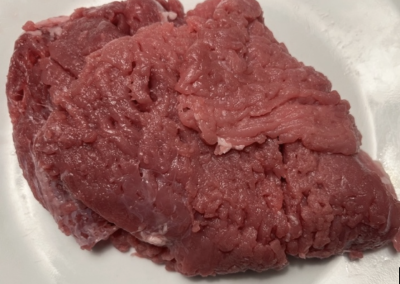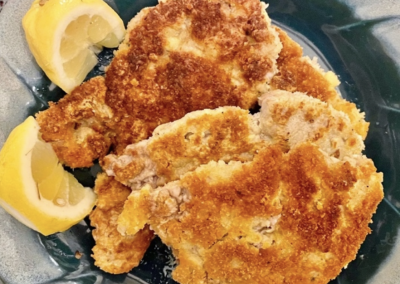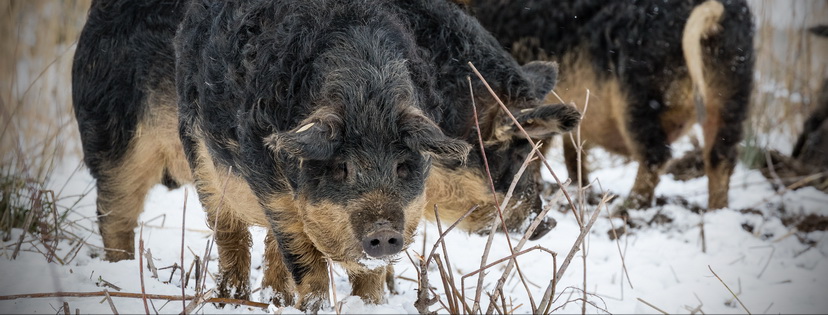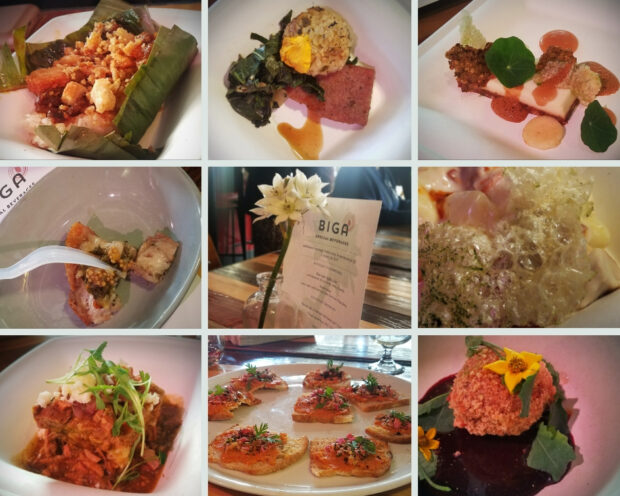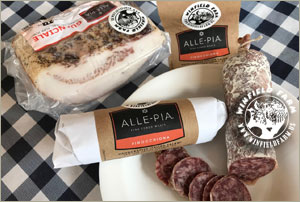Blog & News
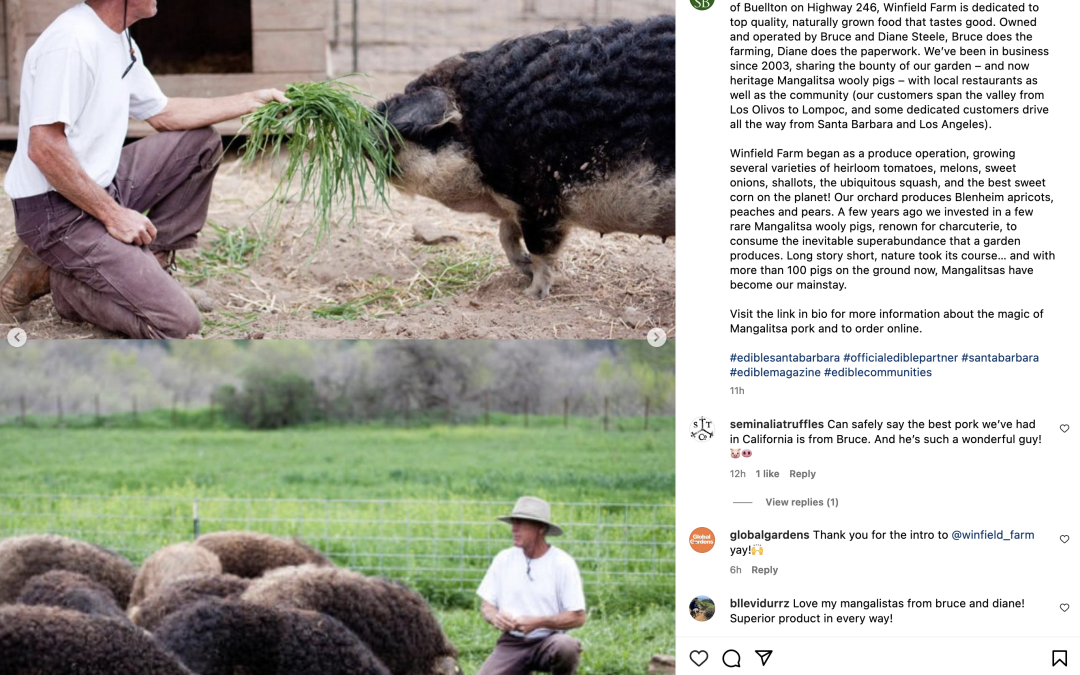
New Profile in Edible Santa Barbara Magazine
We’re so happy to report this neat profile of Winfield Farm Edible Santa Barbara Magazine posted on their Instagram:
Nestled in the Santa Ynez River valley 3 miles west of Buellton on Highway 246, Winfield Farm is dedicated to top quality, naturally grown food that tastes good. Owned and operated by Bruce and Diane Steele, Bruce does the farming, Diane does the paperwork. We’ve been in business since 2003, sharing the bounty of our garden – and now heritage Mangalitsa wooly pigs – with local restaurants as well as the community (our customers span the valley from Los Olivos to Lompoc, and some dedicated customers drive all the way from Santa Barbara and Los Angeles).
Winfield Farm began as a produce operation, growing several varieties of heirloom tomatoes, melons, sweet onions, shallots, the ubiquitous squash, and the best sweet corn on the planet! Our orchard produces Blenheim apricots, peaches and pears. A few years ago we invested in a few rare Mangalitsa wooly pigs, renown for charcuterie, to consume the inevitable superabundance that a garden produces. Long story short, nature took its course… and with more than 100 pigs on the ground now, Mangalitsas have become our mainstay.

Announcing a New Mangalitsa Product
Winfield Farm is pleased to announce that we’re now working with a new USDA butcher – Old Fashion Country Butcher in Santa Paula. Kent Short is a third-generation butcher extraordinaire – the genius who turned us onto Mangalitsa collar steaks and secreto. His most recent suggestion is a cut that he labels “top round steak.”
Thin-sliced from the culatello – the large upper muscle of the ham leg – this cut is extremely versatile, as well as flavorful. For our trial run, Kent sliced the ham steaks to about 1/2 inch thickness, then ran them through a tenderizer. Bruce also lightly pounded the meat before cooking, and the steaks came out very tender. He’s now thinking the steaks don’t need extra tenderizing – a light pounding will be sufficient.
Bruce made Mangalitsa pork schnitzel for our first taste-test, following a simple recipe:
Dust the steaks with lightly seasoned flour, dip in egg wash (some recipes also call for adding milk to the egg wash, but Bruce used straight beaten eggs). He then coated the steaks with Panko and fried them quickly in a hot pan on both sides until golden brown. Bruce fried the steaks in our Mangalitsa lard, rather than butter, to enhance the flavor.
(Mangalitsa lard is actually better than butter – high in oleic acid and low in saturated fat – it melts in your mouth!)
Some recipes call for seasoning the pan with a thyme sprig before adding the steaks, or you could add a pinch of thyme to the seasoned flour, as Bruce did.
Serve with lemon wedges – a must – a squeeze of lemon juice adds freshness and tang that completes the dish.
Garnishing the plate with a thyme sprig also is optional. Our taste-test was a rousing success! Delicious!!
This cut is also great for pork cutlets or chicken-fried steak.

Serving a New Restaurant: First and Oak in Solvang
We are thrilled to be serving a new restaurant!
Sourcing sustainable meat and seafood is at the heart & soul of what they do at First and Oak, located inside the Mirabelle Inn, in the heart of Solvang, California. Proud recipients of a Michelin Plate designation, they offer a seasonal menu that highlights local & organic ingredients prepared in a thoughtful manner. Their finely curated courses are all about transcending flavors, featuring unique surprises such as our Mangalitsa loin chops.
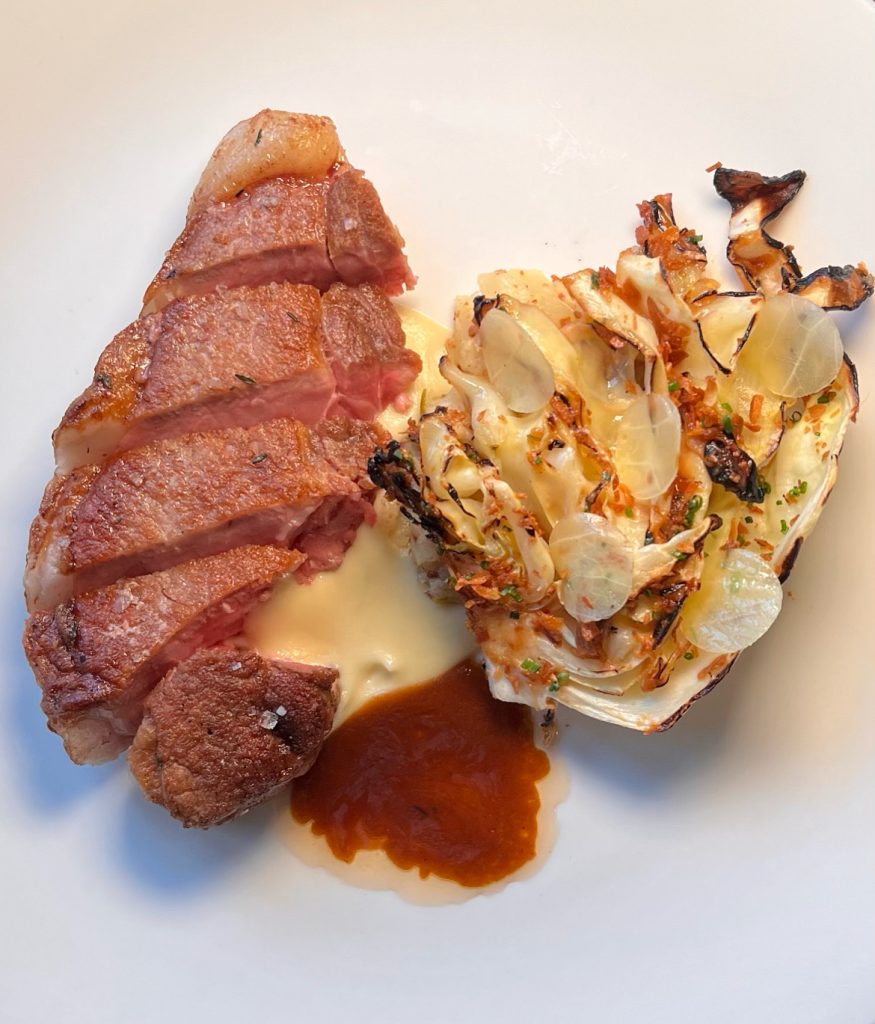
Mangalitsa Loin Chop
They love to highlight small farms like us that share the same passion. Here’s what they say about Winfield Farm:
View this post on Instagram
How To Prepare and Cook Mangalitsa Tri-Tip -The Kobe Beef of Pork
A video from UKULELE JAY BBQ.
Hope you enjoy and please SUBSCRIBE and make sure to follow more UKULELE JAY BBQ on INSTAGRAM @ukulelejaybbq. Another one for the SCINTILLATION STATE!
A culinary culture collision: Porchetta, a Hungarian pig and a South Korean Chef
It sounds like the opening of a joke – A Hungarian pig, an Italian recipe and a South Korean Chef meet in a bar – but the pig roast at BIGA in San Diego was nothing to laugh at. There were however plenty of grins as Chef/Owner, Tae Dickey demonstrated his take on an Italian classic Porchetta Roll. Then the afternoon unfolded into a foodies dream. Six acclaimed chefs incorporated pork into eight tasting courses. Delicious ciders from Bivouac and Duck Foot Brewing’s gluten-free beers were on tap. Regal Wines poured Italian vintages. While culinary culture took a turn away from tradition, satisfaction was definitely served.
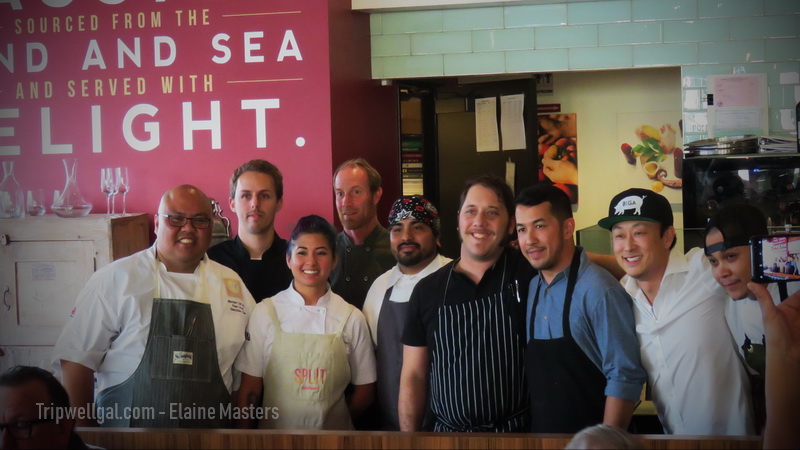 BIGA Anniversary Chef Collaboration
BIGA Anniversary Chef Collaboration
This was the third BIGA pig roast and there was no doubt the event would be memorable given the chefs in attendance. There was Davin Waite from Wrench and Rodent. Whenever he shows up get ready for inspired bites. Willy Eick of Mission Bar and Grill has mastered the art of blending traditions deliciously. Carlos Rodriguez, chef de cuisine at BIGA, stirs his Texan roots and Puerto Rican influences in uniquely apt ways.
Evan Cruz of Arterra flavors his creations with a Filipino twist. Johnny Dolan of The Lion’s Share was instrumental in bringing it all together. Pastry Innovator, Kristianna Zabala of Split Bake House presented a plateful of tasty textures in a petite dessert flan laced with lard. But the star performance was Tae Dickey’s Porchetta Roll and the demonstration of his signature dish. You’ll find it on the menu every Saturday at BIGA.
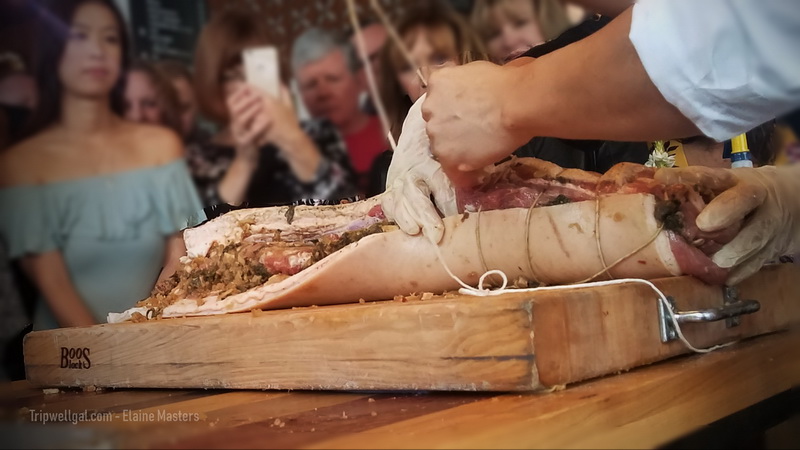 Chef Dickey assembling his Porchetta Roll at BIGA
Chef Dickey assembling his Porchetta Roll at BIGA
Chef Dickey is no stranger to culinary culture clashes. He was born in South Korea but moved to Italy with his family as a teenager. He attended the Culinary Institute in Hyde Park, New York before opening BIGA three years ago. Those Italian years branded his cooking sensibilities but he’s not reverent about sticking with tradition. Before the anniversary meal progressed he summoned the crowd to a table near the entry windows. A large tray held a side of pork nest to a row of porcine steaks and a bowl of savory greens. Slapping the smooth pork side, Dickey confessed that “Italians tell you to beat the hell out of that skin” but he doesn’t. His secret is sprinkling baking soda over the surface lightly. “As we learned in chemistry class, baking soda is a natural tenderizer,” then he cautioned that after a few hours it’s important to wipe the soda off. Porchetta is traditionally done with pork loin but Chef Dickey favors a Heritage Breed, the Mangalista Pig.
Watch my video about the Mangalista Pigs and Chef Dickey’s Porchetta:
These pigs are nothing to laugh at either. They grow large and wooly and were originally bred in Hungary, becoming one of the fattest pigs in the world. The rush to Communism almost led to their extinction as meatier breeds became popular. Luckily with recent trends towards all things bacon, demand for the pigs has crossed culinary culture borders. Of course, American farmers were curious and a few are raising these porcine wonders. Near Buellton, California at the Winfield Farm big, curly Mangalitsa Pigs have taken over.
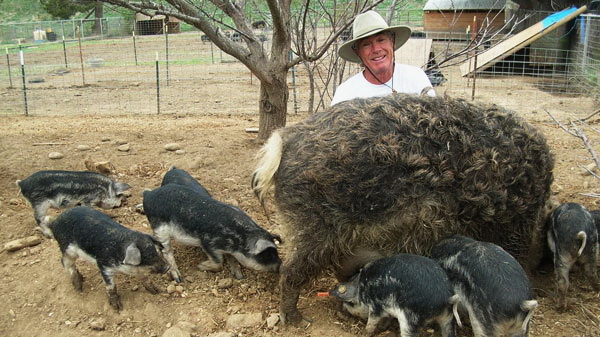 Bruce Steel and one of his prized Mangalista Mommas at Winfield Farm
Bruce Steel and one of his prized Mangalista Mommas at Winfield Farm
Owners Bruce and Diane Steele were growing organic vegetables when they decided to add a few pigs. The idea was to feed them with their unmarketable castoffs and past date veggies. They scooped up the acorns growing on their acres of ranchland to finish off the pigs’ diet before going to market. It worked too well as the pigs flourished and then drought conditions hampered their farming. Today they create a range of products including Leaf Lard, which is the highest grade and lower in saturated fat than other animals. It’s also higher in heart-healthy monounsaturated fat. If that’s hard to swallow remember that that’s the same kind of fat that gives olive oil its healthy reputation.
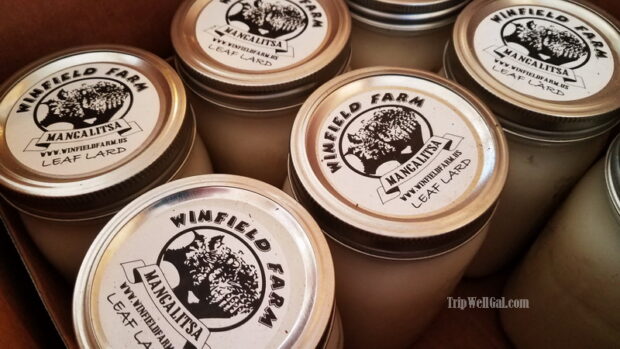 Leaf Lard by the quart from Winfield Farm.
Leaf Lard by the quart from Winfield Farm.
Visit the Mangalica Pig Festival
 Hungarian Parliament in springtime
Hungarian Parliament in springtime
Original post: https://www.tripwellgal.com/culinary-culture-collision-italian-porchetta-hungarian-pig-south-korean-chef/
SPRING ’19 SPECIAL
Life is good at Winfield Farm this spring! In celebration, we’re pleased to offer this SPRING ’19 SPECIAL on some very special Mangalitsa products.
Mangalitsa Finocchiona salami is now available through our online Mangalitsa Market, cured by Alle Pia Fine Cured Meats. (USDA approved, Alle Pia also cures our Mangalitsa Lardo. You can order Mangalitsa lardo directly from Alle Pia.
http://www.allepiasalumi.com/products/lardo )
Finocchiona salami gets its flavor from traditional Chianti wine from Italy, crushed fennel seeds and black pepper. Finocchiona is one of the most loved among Tuscan pork products. Its name derives from “finnocchio”, or fennel, with the crushed seeds added for enriched taste and aroma.
7 ounces of pure deliciousness!!
$16 each
We also asked Alle Pia to cure Mangalitsa guanciale, traditional pork jowl, for us – an absolute must for creating authentic dishes like carbonara or Amatriciana. The higher fat content melts like magic over pastas and sautees. Slice thin or dice and add to any dish. Eat it plain, put thin slices over warm bread as an appetizer, sauté in pan with onions, add to spinach or any other dish for amazing flavor.
$25 per pound (vacuum sealed packages average approx. 2+ pounds)
This spring, we also have on hand a bountiful supply of:
Mangalitsa large link sausage –
Flavors: Sweet Italian and Sheboygan Bratwurst
$12 per pound (packs contain 3 links, approx. 1 pound)
Mangalitsa Babyback Ribs
$12 per pound (racks average 1+ pound)
Full rack spare ribs
$10 per pound (racks average 1.5 – 2 pounds+)
Mangalitsa bone-in sirloin chops
$15 per pound (chops average .5 to .75 pounds each)
If you haven’t tried Mangalitsa, you REALLY should –– and taste the Magic for yourself. To entice you, here’s a
SPRING ’19 SPECIAL – 10 percent discount on the products listed above.
To order please email us directly at:
bruce@winfieldfarm.us and indicate
“Spring 19 Special” in the subject line.
(Please make sure to include your shipping address and telephone number in your order.)
We will invoice you via PayPal and you can pay with credit card online.
(Please note: Offer is good while supplies last, or until May 31, 2019)
This special offer is NOT posted on our online Mangalitsa Market.
(Note: Special offer excludes shipping/handling cost.
Winfield Farm ships via Golden State Overnight to western states only — WA, OR, CA, NV, ID, UT, AZ, NM.)
The Feast of Apicius — Sat. Oct. 20, 2018
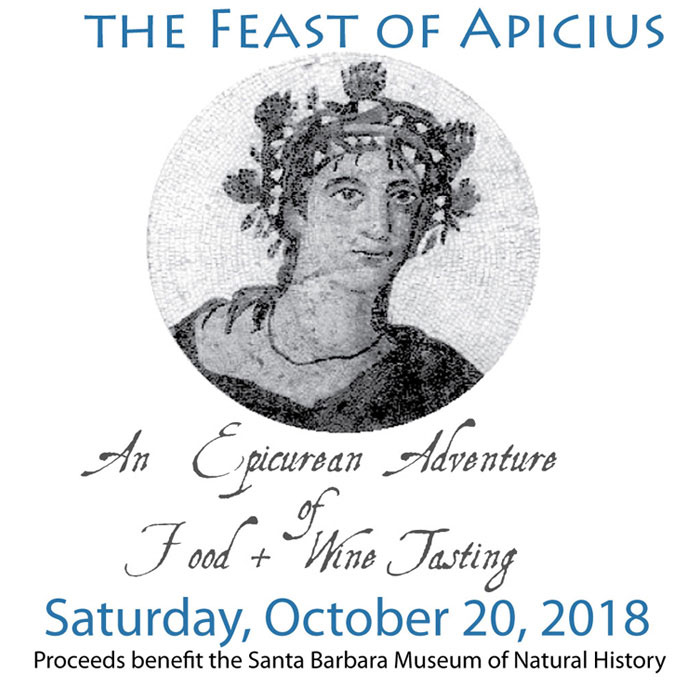
Join Winfield Farm and Grimm’s Bluff winery at the “Feast of Apicius” on October 20, 2018 from 2-5 pm in Fleischmann Auditorium at the Santa Barbara Natural History Museum. This delicious wine + food pairing event is the first of its kind in Santa Barbara as it honors the epicure Apicius renown for his hedonistic pursuit of the finest cuisine. Apicius inspired the world’s first cookbook, written in 1st century Rome.
Bruce will be serving Asian Mangalitsa Meatballs with Ginger Honey sauce, infused with Grimm’s Bluff Sauvignon Blanc wine.
The Feast of Apicius
Saturday, October 20, 2-5 pm
Fleischmann Auditorium, Santa Barbara Museum of Natural History
Price: $50.00 /per person. Proceeds benefit the Museum
Tickets must be purchased in advance: Apicius2018
The Neglected Harvest: Acorns
With 41 million Americans facing hunger currently, the search for solutions is constant – all but a scarce few are overlooking the abundant yet neglected harvest many communities fail to see outside their doorsteps despite their very real hunger. America’s acorns could be feeding millions – directly and indirectly. Acorns have long been eaten by people and animals all over the northern hemisphere – there’s nothing to stop us from eating them again or using them to raise animals. For example, some of the finest prosciutto comes from acorn-fed free-roaming Iberico pigs in Spain. Instead of acorns being a landscaping nuisance, we need to embrace them for what they are: hyper-local, nutrient-dense, gluten-free, perennial, wild-foraged food!
The Miracle Acorn
Acorns don’t come every year: instead they form masts, massive yields that occur in intervals every two to a dozen years. You might have a nut tree in your yard like a pistachio that alternates the years it fruits. This large yield allows for an easy harvest and processing, which requires only drying and leaching of the tannins. It is rare, but sometimes an oak tree grows acorns that has no tannins – it is a sweet acorn! We all can gather our own acorns, process them, and eat them or feed them to our animals. You don’t need to be an expert on acorns to gather enough acorns for an entire year within a few hours with a rake and dustpan. It truly is a natural abundance during those mast years!
Imagine gathering all your flour needs for the year in one afternoon. It’s similar to the way hunters take home one or two deer in a few weekends of hunting and save on buying meat from the store the entire winter or even next year. Natural abundance has that kind of ability – it’s what gave early humans the free time to imagine, reflect, and invent new ways of thinking and being. We could be leveraging natural abundances that are already in place to fight hunger and free ourselves from annual grains by embracing the perennial foods already in place.
Living on Acorns
For several seasons now, Winfield Farm’s Bruce Steele has been only eating food grown and raised on his farm as part of a challenge that he and a friend took upon themselves. He relies on acorns in his diet, and he’s planning on scaling up even more by growing oak trees to raise acorns to feed his Mangalitsa pigs which he sells for meat and uses their lard for biodiesel to run his farm in tandem with solar power.
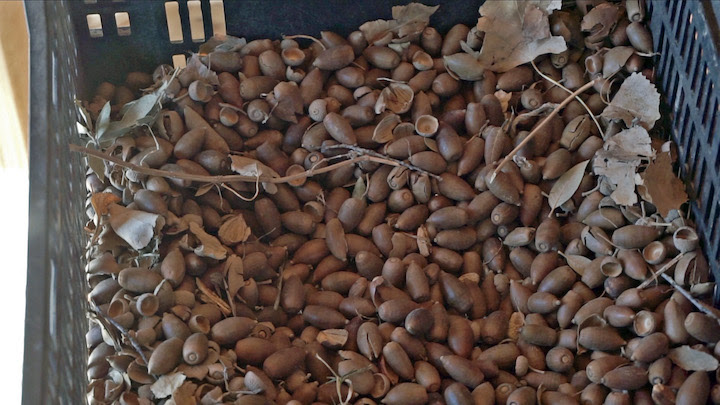
Bruce Steele shares his insights here on drying, leaching, processing, researching, and using acorns:
After collecting acorns you need to spread them out and dry them. This process takes a couple months. Acorns that are cracked or acorns that try to germinate will spoil and need to be thrown away. Sun drying is ideal, but acorns need to be moved indoors if rain or fog threaten. Acorns that fall early in autumn have better drying conditions than acorns that fall later during rain season. Acorns that have dried will separate from the shell and facilitate ease of use with the Davebuilt nutcracker. The nutmeat needs to be separated from the shells, a somewhat time consuming part of processing acorns, but it is during this process that you need to sort out any spoiled or moldy nuts.
The next step is rehydrating the nutmeat overnight with some water in a refrigerator. They can then be a put into a blender (one cup meats and two cups water) and blended into a wet cornmeal consistency. The nutmeat and water are then transferred into one quart mason jars and put back into the refrigerator. Once a day, pour off the liquid but be careful to not pour out the white layer of starch that floats above the blended nutmeat – you can use a natural fiber cheesecloth to do this. After you’ve drained off the tannin-rich liquid, add fresh water. Repeat this process until when you hold a bit of the acorn mush in your mouth, it isn’t bitter at all. This can take 3 – 10 days depending on your acorn type. This is called cold water leaching.
Different acorns require different amounts of time for leaching. Holm oak needs fewer days of leaching than native California oaks. If you can locate Holm oaks, I would suggest using them. There are many different types of oak trees and acorns – you need to experiment with each type to determine how long they take to remove the bitter tannins. This step is critical to making acorn flour for human consumption. If you have access to California black oaks that live at above 3,500 feet in the Sierra then you should try to collect and process them because they were favored by Native American tribes.
I have processed California Live Oak, valley oaks, cork oaks, holm oaks, and Gambel oaks from Arizona. Black oaks are a good species to target. In Arizona there is a species of sweet oak with very low tannins called Emory oaks. All of these western oak species can be processed into acorn flour, but some take more leaching time than others, and some just taste better when you are done.
Once you have finished the leaching process, pass the water, white starch, and nut meat through a strainer, and keep the water: it will have the white starch in it. You can wait till the starch settles and decant the water. This is the part of acorns that the Koreans use for Dotorimuk (Korean acorn jelly). It is very useful as a thickener and can be utilized much like cornstarch. The strained nutmeat can be spread thinly onto a cookie sheet and sun dried. Once dry, a flour mill will turn the dried nutmeat into acorn flour.

Bruce’s methods are just one way to process acorns for food purposes – there are several other ways to do it: you can even leave the acorns in a net bag in a stream for 3-7 days to let the tannins flow out that way! Learning to use your acorn products requires some experimentation in various recipes. Acorn flour has no glutens and will not rise like wheat flour. Some people mix it with wheat flour for cakes or cookies, but if you are using it as a gluten-free flour, then you need to experiment with using beaten egg whites to lighten cookie, cake, or pancake recipes. If you don’t want to use eggs, you could use any other binder you choose. Mark Salter, acorn aficionado, has tried and likes tapioca starch, arrowroot starch, and even cattail starch!
The Oaken Future
While you may not have an oak tree in your yard, your area likely has some, and if not, there’s likely an indigenous edible equivalent in your area that is being similarly neglected. The native oak savanna is an assembly of interrelated species, not just the acorn-bearing canopy tree. As we embrace the cornerstone of an ecosystem and food system that worked in concert, we will see the return of other beneficial species for medicine, fiber, and food. By supporting the oak savanna and native biodiversity, we support so much of what the oaken savanna generated and protected.
When you crack open an acorn, you are participating in a long tradition that spans the northern hemisphere, and one that can open the door to end hunger, break off our reliance upon industrialized agriculture, and embrace an abundant world of wild foods and foraging abundance!
Here’s the article as a PDF, as seen in Issue 09 of Permaculture Magazine.
Lardo is latest darling of animal-fat movement
The Italian fatback finds its way onto salumi plates, burgers and tacos across the US
Fatphobes had better fasten their seatbelts: lardo has landed.
Not to be confused with conventional lard, lardo is indeed fatback, but it’s fatback of a sublime nature. A national treasure in Italy, Lardo di Colonnata is a designated heritage food that’s made from cosseted hogs fed a diet of forest nuts, then cured for months with herbs and spices in special containers made of Carrara marble. After curing, it makes its tissue-thin and toothsome appearance on salumi plates around that country.
It’s not surprising, perhaps, to find it at home, at high-end restaurants here like Rare Steak and Seafood in Washington, D.C., where it’s part of the Pork Tasting appetizer, alongside paté and chicharrón. It’s another thing altogether to see it as a hamburger topper, as has been the case at Farm Burger in Atlanta.
Unctuous in texture and mild in flavor, it plays well with other ingredients. At Cultivar in Boston, the Heritage Headcheese is served with smoked peaches and lemon verbena-whipped lardo. At Seattle’s Staple & Fancy, it made an unexpected appearance in the Baby Beets and Watermelon Salad with lardo and pistachio. It has also made the menu at Le Farfalle in Charleston, S.C., where the special Stringozzi alla Spoletina pasta entrée was finished with lardo and tomato sauce.
It has found a niche in bread baskets, too. Belcampo Meat Co., a restaurant-cum-butchery with seven locations in California, offers bread service with lardo butter, while trendy RPM Italian in Washington, D.C., serves rosemary focaccia with whipped lardo. In a similarly starchy vein, at Speedy Romeo, a next-gen pizza emporium in New York City, whipped lardo tops coal-baked potatoes on the special Triple Crown catering menu.
Lardo has also turned up in some unexpected places, like B.S. Taqueria, which boasts “authentically inauthentic fare” in Los Angeles, of which the Clam and Lardo Tacos is a good example. The sophisticated Lardo-Wrapped Langoustine with white asparagus at Oriole, Chicago’s fine-dining mecca, is another. And somewhere in between is the Little Piggy Muffin from New York’s Dominique Ansel Bakery that’s served with a thin slice of lardo melted over the top.
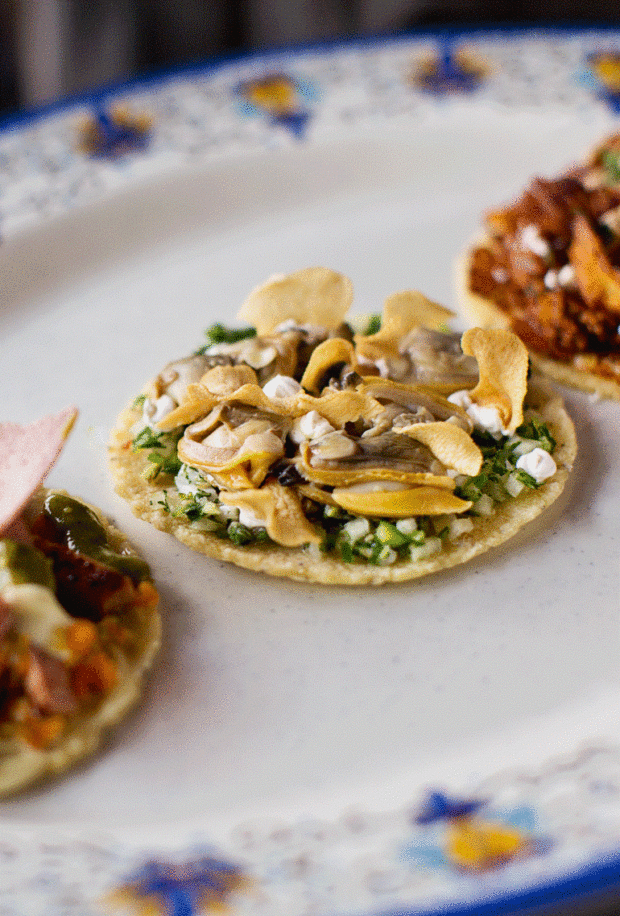
BS Tacqueria’s clam and lardo tacos
The interest in lardo has an all-American cognate, as lard has come back into vogue in restaurant kitchens as well. For many chefs and bakers, of course, it never went out of fashion. Pastry chefs consider it a pie-crust prerequisite, many Southern cooks add a dollop to make their biscuits extra flaky, and it’s SOP at Mexican restaurants, where manteca, or lard, adds depth of flavor and mouthfeel to standards like refried beans and tortillas.
A new generation of operators has succumbed to its fatty charms, like popular, two-unit Bang Bang Pie & Biscuits in Chicago, which boasts that the “leaf lard for our signature pastry crust is rendered specifically for us by our friends at Smoking Goose.” Leaf lard is the highest grade of lard, taken from inside the loin, and it has an especially mild flavor. At nearby Big Jones, the menu pays homage to the people, places and history of the South with dishes like the award-winning fried chicken that is cooked in a combination of leaf lard, ham drippings and clarified butter.
Speaking of homages, Lardo, an OG of the Portland, Ore., food-cart scene, boasts that “it worships at the altar of swine and proudly celebrates its excesses.” The resulting swine-heavy sandwich list has included a Double Burger with lardo alongside the Pork Meatball Banh Mi and Korean Pork Shoulder Sandwich, all of which can be enjoyed with a side of Crispy Pigs Ears with fennel salt or Lardo Fries fried in rendered fatback.
Considering that animal fats have been well and truly stigmatized for the past 50 years, it’s ironic that lard, along with beef tallow, duck fat and chicken schmaltz, is currently climbing the charts on hipster menus around the country. It happens that it is the beneficiary of a unique confluence of factors, including the dramatic fall from grace of trans fats; the rise of the nose-to-tail movement, which has embraced previously discarded pig parts; and, especially, the rediscovery of animal fats by Millennials, especially Millennial parents, who prize their clean, additive-free labels.
There’s a kind of back-to-the-future vibe that would make their great-grandmothers proud.
Original post: http://www.restaurant-hospitality.com/food-trends/lardo-latest-darling-animal-fat-movement
COCHON 555 — MARCH 11, 2018
COCHON 555 RETURNS TO LA
MARCH 11 AT THE VICEROY HOTEL, SANTA MONICA

LOS ANGELES (February 13, 2018) —
If you love a good cause and want to attend one of the country’s most talked about culinary events, then clear your weekend calendar when Cochon555 returns to Los Angeles on March 11, 2018 at the incredible Viceroy Santa Monica. Imagine an elaborate 30-course, stand-up, super sustainable dinner featuring amazing beverages where you get to help pick the best bite from some of the best local chefs.
This year’s all-star cast of chefs – who specialize in whole animal cooking and are paired with farmers responsibly raising delicious heritage breed pigs – include Sammy Monsour of Preux & Proper, Brian Redzikowski of Kettner Exchange, Thomas Bille of Otium, Lord Maynard Llera of Mason and Hugo Bolanos of Wolfgang Puck at Hotel Bel-Air. Butcher Michael Puglisi of Electric City Butcher rounds out a stellar lineup.
We at Winfield Farm are delighted to partner this year with Executive Chef Hugo Bolanos (@hugoalejandrobolanos) of Wolfgang Puck at Hotel Bel Air. On March 1 we will deliver a 200-pound heritage Mangalitsa from which Chef Hugo will make 6 magical dishes.
To win the friendly competition for a cause, a chef’s menu must woo twenty celebrity judges with their “Judge’s Plate” scored on utilization; technique; and overall flavor and be voted “best bite of the day” by guests. The winning “Prince or Princess of Pork” in Los Angeles will advance to the national finale, Grand Cochon, a head-to-tail, winner-takes-all showdown for the crown in Chicago on September 30th.
The ultimate aim of Cochon555 is to provide education to chefs and consumers and create experiences that guests can sink their teeth into: honest food from real farmers. The goal is to raise the bar on building a sustainable and profitable relationship for brands and chefs participating in culinary festivals. For an in-depth look at the distinguished providers behind the Cochon555 movement, to view a video, and to purchase tickets, please visit http://cochon555.com/us-tour/2018-la/
Tickets for general admission start at $130; VIP tickets (early admission + exclusive access to cocktail competition and allocated wines and spirits) are $200.
Where: Viceroy Santa Monica – 1819 Ocean Ave, Santa Monica, CA 90401
When: Sunday, March 11
Time: 4 p.m. for VIP entry, 5 p.m. for General Admission

